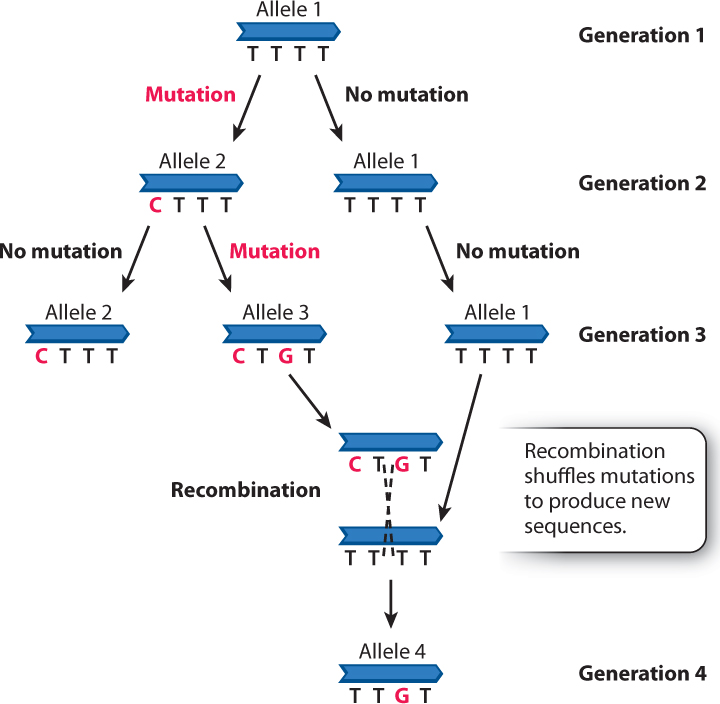21.1 GENETIC VARIATION
Variation is a major feature of the natural world. We humans are particularly good at noticing phenotypic variation among individuals of our own species. As we discussed in Chapter 16, a phenotype is an observable trait, such as human height or wing color in butterflies. Two factors contribute to phenotype: an individual’s genotype, the set of alleles possessed by the individual at relevant genetic loci, and the environment in which the individual lives. We can take the environment out of the equation by looking directly at genotypic differences through sequencing DNA regions in multiple individuals. We now explore genetic variation directly, in terms of differences at the DNA sequence level.
21.1.1 Population genetics is the study of patterns of genetic variation.
Remarkably, in spite of a high degree of phenotypic variation, humans actually rank low in terms of overall genetic variation compared to other species. Specifically, if we ask how many DNA bases differ from one individual to another within the same species, we find that the fruit fly Drosophila melanogaster is about 10 times more genetically variable than we are. Even one of the most seemingly uniform species on the planet, the Adelie penguin seen in Fig. 21.1, is two to three times more genetically variable than we are.

21-2
As we discuss in Chapter 22, a species consists of individuals that can exchange genetic material through interbreeding. From a genetic perspective, a species is therefore a group of individuals capable, through reproduction, of sharing alleles with one another. Individuals represent different combinations of alleles drawn from a single gene pool, that is, all the alleles present in all individuals in a species. The human gene pool includes alleles that cause differences in skin color, hair type, eye color, and so on. Each one of us has a different set of those alleles—alleles that cause brown hair and brown eyes, for example, or black hair and blue eyes—drawn from that gene pool.
Population genetics is the study of genetic variation in natural populations, which are interbreeding groups of organisms of the same species living in the same geographical area. What factors determine levels of variation in a population and in a species? Why are humans genetically less variable than penguins? What factors affect the distribution of particular variations? Population genetics addresses detailed questions about patterns of variation. And small differences, given enough time, can lead to the major differences we see among organisms today.
21.1.2 Mutation and recombination are the two sources of genetic variation.
Genetic variation has two sources: mutation and recombination. Mutation generates new variation and recombination shuffles mutations to create new combinations of mutations. In both cases, new alleles are formed, as shown in Fig. 21.2.

Mutations can be somatic, occurring in the body’s tissues, or germ-line, occurring in the reproductive cells and therefore passed on to the next generation. From an evolutionary viewpoint, we are primarily interested in germ-line mutations. A somatic mutation affects only the cells descended from the one cell in which the mutation originally arose, and thus affects only that one individual. However, a germ-line mutation appears in every cell of an individual derived from the fertilization involving the mutation-bearing gamete, and thus in its descendants.
21.1.3 Mutations can be harmful, neutral, or beneficial.
Organisms, even the very simplest, are exquisitely complicated. In a large multicellular species such as humans, the level of organizational complexity is staggering. Consider the extraordinary process of development whereby, starting from a single cell at conception, an adult human being develops that consists of a few hundred trillion interacting, cooperating cells (Chapter 20). What is the likely impact of a random change—a mutation—on a complex piece of biological machinery? Random changes to the working parts of complex, organized systems are almost always deleterious (harmful). Imagine making a random change to the engine of a car, a relatively simple machine compared to complex biological machines. Pull out a hose here or put in a steel rod there, and you will almost certainly have a problem with your car.
21-3
Many mutations, however, have little or no effect on the organism. These mutations are neither deleterious nor advantageous because they occur in regions of the genome that are not functionally important. Such mutations are termed neutral.
Occasionally, a mutation occurs that is actually beneficial in terms of survival or reproduction. For example, a gene encoding hemoglobin might by chance acquire a mutation that allows it to take up and deliver oxygen to tissues more easily. Similarly, a gene encoding a particular enzyme might be mutated in such a way that it is more efficient at catalyzing a chemical reaction. Mutations like these are considered advantageous if they improve their carriers’ chances of survival or reproduction. Advantageous mutations, as we will see, can increase in frequency in a population until eventually they are carried by every member of a species. These mutations are the ones that result in a species that is adapted to its environment—better able to survive and reproduce in that environment.